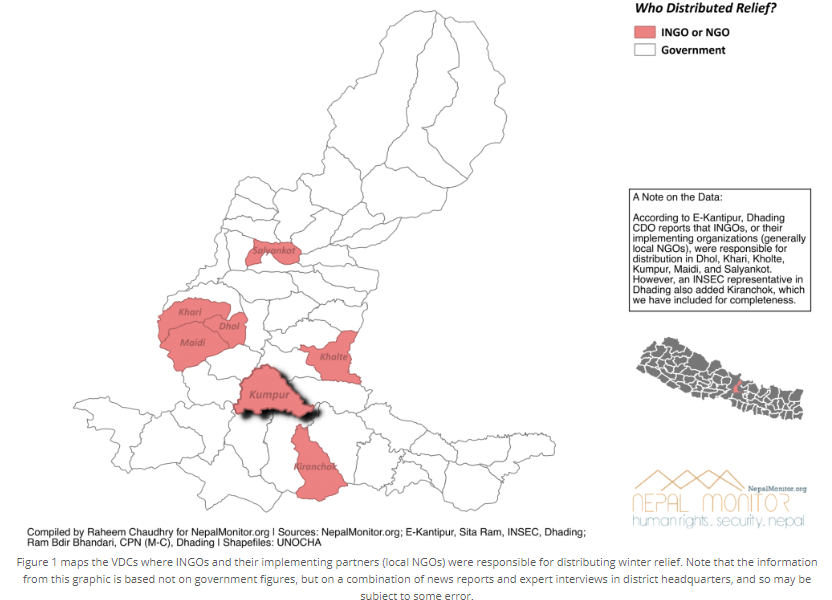Analysis
Following up on Protests Over Winter Relief in Kumpur
2016-08-09

On 28 January 2016, Nepal Monitor mapped a report that 1,000 citizens from the Kumpur VDC protested the District Administration Office. Their core complaint was that they were not given the winter relief they were promised and, further, that some VDCs were prioritized in the process, sometimes receiving significantly more aid than other VDCs.
A few weeks ago, our team spent some time visited Dhading Besi to gain a better understanding of community tensions during the relief phase following the April 2015 earthquake. However, while we were there we also developed insight into this earlier incident.
Sitaram Adhikari, an INSEC representative based in Dhading Besi, helped us gain a better understanding of the situation. Mr. Adhikari explained that the government decided to allocate an additional 10,000 rupees to affected households for winter relief. In Dhading, the government disbursed cash in all but a handful of VDCs. For the other VDCs, the government partnered with INGOs for the disbursal of aid. In Khalte and Kiranchok, for instance, the Red Cross distributed 10,000 rupees in cash and there were no problems.
However, in Kumpur, the NGO chosen to distribute relief chose to distribute cash vouchers instead of cash. This NGO also contracted with retailers who locals felt inflated prices because they could not use these vouchers elsewhere. Ram Bdr Bhandari, the leader of the CPN(M-C) chapter based out of Dhading Besi, added that, not only were materials overpriced, but they were also lacking in quality. Zinc sheets, for instance, were flimsy and already needed to be replaced.
Mr. Bhandari argued that the lack of transparency by the government during the relief and reconstruction process has bred mistrust. For example, he openly wondered why the government did not directly distribute resources in Kumpur when it did in the majority of the VDCs in Dhading. Moreover, it is unclear to Mr. Bhandari how the government chose partner INGOs to distribute winter relief, and how or why the NGO in Kumpur chose to disburse the aid with cash vouchers, redeemable only with specific retailers. It is easy to wonder, Mr. Bhandari said, whether corruption had a role to play in the NGO’s calculus.
The government, Mr. Bhandari insisted, could have avoided this situation. He argued that the government should have been more transparent in its process. The residents of Kumpur deserved to know why they were receiving cash vouchers when the rest of the district received cash. Mr. Bhandari also believed that the government must hold implementing partners accountable. NGOs often proclaim that the are accountable only to the people and to their donors. However, he said, the NGO working in Kumpur should have been accountable to the government given that it had a contract with them. Moreover, he argued that it was the government primarily at fault for agreeing to let an NGO disburse relief without doing the hard work of monitoring progress.
It is unclear whether corruption or nepotism played a role in the NGO’s decision to distribute cash vouchers instead of cash grants, or to contract with specific retailers. However, this is almost irrelevant as there is a real perception among local communities that corruption does play a role if they perceive an unfair or unequal distribution of resources. And, so long as that perception exists, there will always exist the opportunity for tension between locals and the government that serves them. At every level, then, the government would do well to be transparent and, more broadly, engage with local leaders to ensure that the needs of every citizen are being met.
Raheem Chaudhry is an AidData Summer Fellows working in Kathmandu with Nepal Monitor this summer. He is a graduate student at The University of Texas, Austin, where he works for Innovations for Peace and Development, a research organization affiliated with AidData. Raheem is pursuing his Masters in Public Affairs and anticipates graduating this August.

